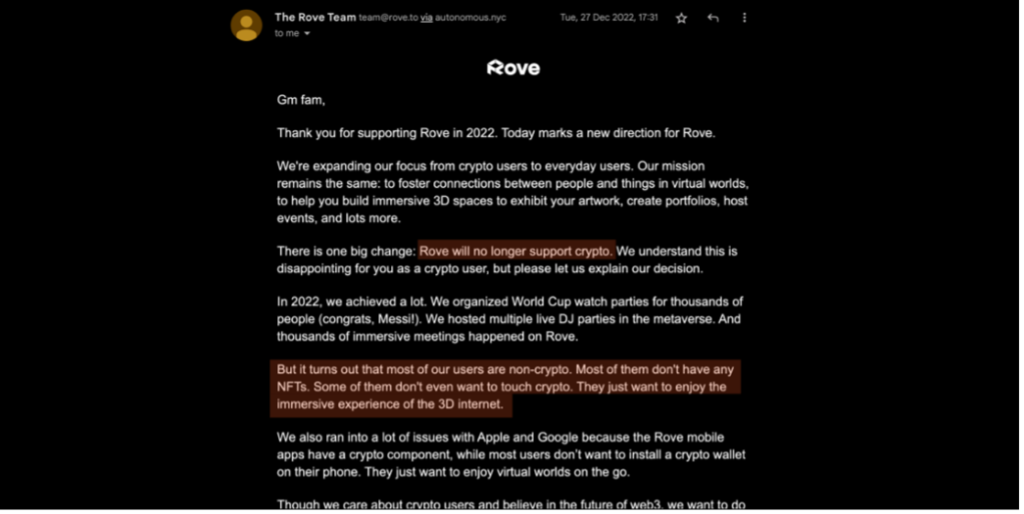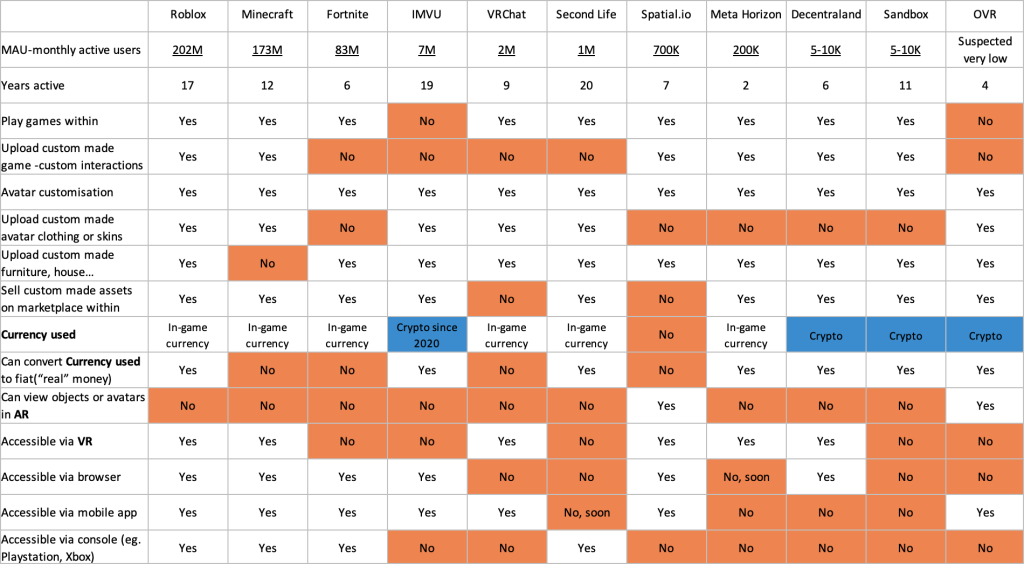What is the metaverse and what can it do for your brand?

There are a couple of tech buzzwords that come to everyone’s mind when looking back over the past few years. And one of them is the “metaverse”. But what is it? Let’s dive into it, see what brands are doing, and explore what your brand can do.
But first, why should you care? Well, McKinsey thinks it might generate up to $5 trillion in value by 2030. JPMorgan bets metaverse is a $1 trillion yearly opportunity, and as of recently, investment giant BlackRock is offering an ETF that will focus primarily on tech companies that are exposed to the metaverse. Every year, $54 billion is spent on virtual goods – that’s almost double the amount spent on buying music.
In 2021, approximately 2.5 billion chat messages were sent and 17 million friendships were made on Roblox daily. GDP for Second Life was about $650M in 2021 with nearly $80M
USD paid to creators. According to IZEA research, 70% of influencers believe that the metaverse will replace social media and 71% of social media users support ads and brand partnerships in the metaverse.
The origins of the metaverse
Metaverses date all the way back to the Web1 period – the 1990s. Back then, they were called virtual worlds. In the 2000’s, particularly before the financial crash, virtual worlds were people’s favourite form of escapism. They eventually got attributed to Web2, much like metaverses are now attributed to Web3. And just like back then, now that the world is facing financial hardships, the interest for the virtual is growing.

So, what is the metaverse?
Pop culture and media references
In science fiction books and movies, the metaverse is usually thought of as the hypothetical iteration of an immersive 3D internet using AR and VR headsets. And in media, we’ve seen everything from basic 3D branded rooms to 360 videos being referred to as the metaverse.
What instead of this universal metaverse idea, we’re seeing further fragmentation of it. Big tech, gaming and other companies are all on a quest to create their own metaverses and amass the biggest audience.
Basic elements: socialising, interacting, gaming
Metaverses combine the social aspect of virtual worlds with the entertainment aspect of open world games.
These 3D virtual worlds are focused on interaction amongst users, and with the environment itself. Within the metaverse, people can socialise via voice or text, using personalised avatars as vessels for their real-life selves. They can interact with environment elements or avatars, and also play games.
There is usually some real life-like economics involved. For example, users can own or purchase a piece of land. They can then decorate it to their liking with elements available on the built-in marketplace. Similarly, users can purchase avatar skins.
Within some metaverses, users can upload and sell their own creations, such as avatar skins and elements to be placed on the land. This feature further solidifies the co-creation relationship between brand and user. Some metaverses like Meta Horizon, Roblox or Spatial even allow users to upload games that they’ve created themselves.
This is why you’ll often see games like Minecraft or Roblox being referred to as metaverses. They tick all the element boxes such as socialising, interacting, gaming, marketplace, ownership, and co-creation.
Plus, less utilised elements: blockchain, VR, AR
There is even more to metaverses. Sometimes, they also incorporate blockchain, VR and AR.
In the case of blockchain, the marketplace assets and pieces of land will be up for purchase for a certain amount of cryptocurrencies instead of the in-game currency like Robux in Roblox. Most popular blockchain metaverses like Decentraland and Sandbox are struggling to form an audience due to lack of mass interest or literacy of blockchain (even amongst investors), overall detest from the gaming industry and recent scandals surrounding it. Some metaverses like Rove.to – which initially started off as blockchain based – are distancing themselves completely from it. Disney is also scrapping their polygon crypto based metaverse idea. Additionally, Meta is giving up on NFTs, which means we won’t see them integrated within Meta Horizon Worlds metaverse.

There are some metaverses that are giving users the opportunity to have an experience using a VR headset (for example, VRChat). Other VR-only-available metaverses like Meta Horizon have realised that VR should be optional and that it could present a potential barrier, prompting them to announce development of browser-accessible and mobile versions – something Spatial.io has already enabled.
On the other hand, incorporating AR doesn’t mean an AR headset is mandatory. A good example is the OVR metaverse where users purchase land representing pieces from the real world, and where they can place AR objects. Say you owned New York Times Square in the OVR metaverse, then only you can place AR objects on it – visible via the OVR mobile app in AR when the user is on Times Square physically. Though an interesting and smart concept, it has not created significant buzz yet.

What big brands are doing
Apart from the DMO’s of countries like Saudi Arabia and South Korea, there has been very little talk of brands investing in their own metaverses. Rather than committing to creating an entire metaverse, lots of brands have been pushing out virtual 3D pop-up stores like the Nike virtual store, Complex Land yearly virtual store experience or the Charlotte Tilbury store.
Most metaverse efforts from brands are focused on placing their brand within some of the existing metaverses. For example:
- Walmart in Roblox
- Balenciaga in Fortnite
- Collina Strada and other fashion brands in IMVU
- Burberry in Minecraft
- Nissan in VRChat
- Vogue Singapore in Spatial
- Samsung in Decentraland
Others are creating 360 video or 3D experiences with no basic metaverse elements and labelling them as the metaverse for SEO purposes.
What brands we work with can do
The real answer is, with the right partner with the right resources, brands can do anything. As a full-service company, Emakina alongside EPAM offers a great range of metaverse services, ranging from simple and seamless integration of brands within metaverses to the creation of full-blown metaverses that can host millions of concurrent users.
However, just because brands can, doesn’t mean they should rush to jump on the hype train. Much like the NFT craze, we’ve seen a lot of metaverse activations deliver underwhelming experiences for the user. A nice PR piece on a brand doing it might bring some temporary gains – but at what cost? Poorly executed events, deceptive marketing, and unexpected loss of funds and high gas fees are just some of the hardships users have faced.

Blender, Unity, Spatial and Unreal Engine as well as experimenting
with virtual human creation using Unreal‘s Metahuman.
How brands can deliver extraordinary metaverse experiences
The best way for a brand to deliver standout metaverse experiences is to look for a strategic and well-educated approach with the user at the centre. The approach needs to be carefully tailored to the industry, current and target audiences, and the mechanics and demographics behind the various metaverses – should a brand want to enter an existing metaverse.
Understanding target audiences and their wants and desires is extremely important to achieving engagement and properly reaching out to them. Dismissing it can lead to experiences no-one attends – like the European Parliament metaverse gala concert.
THINK: A user’s time is extremely valuable. After all – why should they visit your metaverse with a choice of so many? What problem are you solving or what benefit is hiding, if any?
Brands must not ignore the importance of a good story. People connect with stories and narratives. Users are searching for stories that are entertaining and speak to their inner child, wishes, desires and hopes. Creating a compelling story that will get users interested is a lot harder than just pushing out an experience, yet it can make all the difference and help exceed the predicted results of your metaverse efforts.
THINK: What journey or narrative do you want to take your users along? And what thought do you want to leave them with?
Lastly, it’s important to nail down to the nitty gritty of the technology part, from making the experience accessible via all devices preferably, to the tech stack making it all run.
THINK: Do your users have sufficient equipment to run the experience you want to create? How many users can your metaverse or the metaverse you’re entering host without crashing or causing interruptions? How heavy can your 3D files be for the experience to run smoothly?
Want to step into the opportunities of metaverse?
If you’re interested in creating a metaverse, virtual store or AR/VR experience, we have the experts with the industry experience, creativity and technology expertise to guide you through every step of that journey. Together, we can look at your user needs and create a strategy for your brand to seamlessly enter the metaverse. This strategy covers digital branding, digital products and services, as well as digital commerce with potential integration of NFTs, digital collectibles and tokens. The metaverse can present a great opportunity for innovation and expansion, and we look forward to exploring it with you.



